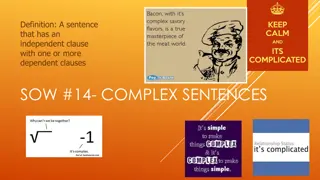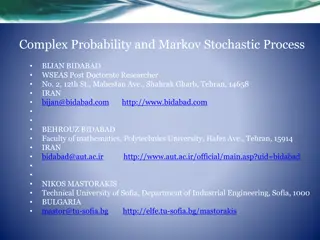Understanding Independent and Dependent Events in Probability
Explore the concepts of independent and dependent events in probability, learn how to determine the probability of independent events using examples, and find out the difference between the two types of events through clear explanations and illustrations. Enhance your understanding of conditional probability and improve your probability calculation skills with practical examples and visual aids.
Download Presentation

Please find below an Image/Link to download the presentation.
The content on the website is provided AS IS for your information and personal use only. It may not be sold, licensed, or shared on other websites without obtaining consent from the author. Download presentation by click this link. If you encounter any issues during the download, it is possible that the publisher has removed the file from their server.
E N D
Presentation Transcript
Independent and Dependent events
Warm Up There are 5 blue, 4 red, 1 yellow and 2 green beads in a bag. Find the probability that a bead chosen at random from the bag is: 1. blue 2. green 3. blue or green 4. blue or yellow 5. not red 6. not yellow
Objectives Determine whether events are independent or dependent. Find the probability of independent and dependent events.
Vocabulary independent events dependent events conditional probability
Events are independent events if the occurrence of one event does not affect the probability of the other. If a coin is tossed twice, its landing heads up on the first toss and landing heads up on the second toss are independent events. The outcome of one toss does not affect the probability of heads on the other toss. To find the probability of tossing heads twice, multiply the individual probabilities,
Example 1A: Finding the Probability of Independent Events A six-sided cube is labeled with the numbers 1, 2, 2, 3, 3, and 3. Four sides are colored red, one side is white, and one side is yellow. Find the probability. Tossing 2, then 2. Tossing a 2 once does not affect the probability of tossing a 2 again, so the events are independent. P(2 and then 2) = P(2) P(2) 2 of the 6 sides are labeled 2.
Example 1B: Finding the Probability of Independent Events A six-sided cube is labeled with the numbers 1, 2, 2, 3, 3, and 3. Four sides are colored red, one side is white, and one side is yellow. Find the probability. Tossing red, then white, then yellow. The result of any toss does not affect the probability of any other outcome. P(red, then white, and then yellow) = P(red) P(white) P(yellow) 4 of the 6 sides are red; 1 is white; 1 is yellow.
Check It Out! Example 1 Find each probability. 1a. rolling a 6 on one number cube and a 6 on another number cube P(6 and then 6) = P(6) P(6) 1 of the 6 sides is labeled 6. 1b. tossing heads, then heads, and then tails when tossing a coin 3 times P(heads, then heads, and then tails) = P(heads) P(heads) P(tails) 1 of the 2 sides is heads.
Events are dependent events if the occurrence of one event affects the probability of the other. For example, suppose that there are 2 lemons and 1 lime in a bag. If you pull out two pieces of fruit, the probabilities change depending on the outcome of the first.
The tree diagram shows the probabilities for choosing two pieces of fruit from a bag containing 2 lemons and 1 lime.
The probability of a specific event can be found by multiplying the probabilities on the branches that make up the event. For example, the probability of drawing two lemons is .
To find the probability of dependent events, you can use conditional probability P(B|A), the probability of event B, given that event A has occurred.
Example 2A: Finding the Probability of Dependent Events Two number cubes are rolled one white and one yellow. Explain why the events are dependant. Then find the indicated probability. The white cube shows a 6 and the sum is greater than 9.
Example 2A Continued Step 1 Explain why the events are dependant. Of 36 outcomes, 6 have a white 6. Of 6 outcomes with white 6, 3 have a sum greater than 9. The events the white cube shows a 6 and the sum is greater than 9 are dependent because P(sum >9) is different when it is known that a white 6 has occurred.
Example 2A Continued Step 2 Find the probability. P(A and B) = P(A) P(B|A) P(white 6 and sum > 9) = P(white six) P(sum > 9|white 6)
Example 2B: Finding the Probability of Dependent Events Two number cubes are rolled one white and one yellow. Explain why the events are dependant. Then find the indicated probability. The yellow cube shows an even number and the sum is 5.
Example 2B Continued The events are dependent because P(sum is 5) is different when the yellow cube shows an even number. Of 36 outcomes, 18 have a yellow even number. Of 18 outcomes that have a yellow even number, 2 have a sum of 5.
Example 2B Continued P(yellow is even and sum is 5) = P(yellow even number) P(sum is 5| yellow even number)
Check It Out! Example 2 Two number cubes are rolled one red and one black. Explain why the events are dependent, and then find the indicated probability. The red cube shows a number greater than 4, and the sum is greater than 9.
Check It Out! Example 2 Continued Step 1 Explain why the events are dependant. Of 36 outcomes, 12 have a red greater than 4. Of 12 outcomes with a red number greater than 4, 5 have a sum greater than 9. The events the red cube shows > 4 and the sum is greater than 9 are dependent because P(sum > 9) is different when it is known that a red cube that shows a number greater than 4 has occurred.
Check It Out! Example 2 Continued Step 2 Find the probability. P(A and B) = P(A) P(B|A) P(red > 4 and sum > 9) = P(red > 4) P(sum > 9| red > 4)
Conditional probability often applies when data fall into categories.
Example 3: Using a Table to Find Conditional Probability The table shows domestic migration from 1995 to 2000. A person is randomly selected. Find each probability. Domestic Migration by Region (thousands) Region Immigrants Emigrants Northeast 1537 Midwest 2410 South 5042 West 2666 2808 2951 3243 2654
Example 3 Continued A. that an emigrant is from the West Use the emigrant column. Of 11,656 emigrants, 2654 are from the West. B. that someone selected from the South region is an immigrant Use the South row. Of 8285 people, 5042 were immigrants.
Example 3 Continued C. that someone selected is an emigrant and is from the Midwest Use the Emigrants column. Of 11,656 emigrants, 2951 were from the Midwest. There were 23,311 total people.
Check It Out! Example 3a Using the table on p. 813, find each probability. that a voter from Travis county voted for someone other than George Bush or John Kerry Of those in Travis 148,000 voted for Bush, 197,000 for Kerry and 5000 for other.
Check It Out! Example 3b Using the table on p. 813, find each probability. that a voter was from Harris county and voted for George Bush Of the 1,058,000 who voted for Bush, 581,000 were from Harris County. There were 3,125,000 total voters.
In many cases involving random selection, events are independent when there is replacement and dependent when there is not replacement. Remember! A standard card deck contains 4 suits of 13 cards each. The face cards are the jacks, queens, and kings.
Example 4: Determining Whether Events Are Independent or Dependant Two cards are drawn from a deck of 52. Determine whether the events are independent or dependent. Find the probability.
Example 4 Continued A. selecting two hearts when the first card is replaced Replacing the first card means that the occurrence of the first selection will not affect the probability of the second selection, so the events are independent. P(heart|heart on first draw) = P(heart) P(heart) 13 of the 52 cards are hearts.
Example 4 Continued B. selecting two hearts when the first card is not replaced Not replacing the first card means that there will be fewer cards to choose from, affecting the probability of the second selection, so the events are dependent. P(heart) P(heart|first card was a heart) There are 13 hearts. 12 hearts and 51 cards are available for the second selection.
Example 4 Continued C. a queen is drawn, is not replaced, and then a king is drawn Not replacing the first card means that there will be fewer cards to choose from, affecting the probability of the second selection, so the events are dependent. P(queen) P(king|first card was a queen) There are 4 queens. 4 kings and 51 cards are available for the second selection.
Check It Out! Example 4 A bag contains 10 beads 2 black, 3 white, and 5 red. A bead is selected at random. Determine whether the events are independent or dependent. Find the indicated probability.
Check It Out! Example 4 Continued a. selecting a white bead, replacing it, and then selecting a red bead Replacing the white bead means that the probability of the second selection will not change so the events are independent. P(white on first draw and red on second draw) = P(white) P(red)
Check It Out! Example 4 Continued b. selecting a white bead, not replacing it, and then selecting a red bead By not replacing the white bead the probability of the second selection has changed so the events are dependent. P(white) P(red|first bead was white)
Check It Out! Example 4 Continued c. selecting 3 nonred beads without replacement By not replacing the red beads the probability of the next selection has changed so the events are dependent. P(nonred) P(nonred|first was nonred) P(nonred|first and second were nonred)
Lesson Quiz: Part I 1. Find the probability of rolling a number greater than 2 and then rolling a multiple of 3 when a number cube is rolled twice. 2. A drawer contains 8 blue socks, 8 black socks, and 4 white socks. Socks are picked at random. Explain why the events picking a blue sock and then another blue sock are dependent. Then find the probability. P(blue|blue) is different when it is known that a blue sock has been picked;
Lesson Quiz: Part II 3. Two cards are drawn from a deck of 52. Determine whether the events are independent or dependent. Find the indicated probability. A. selecting two face cards when the first card is replaced independent; B. selecting two face cards when the first card is not replaced dependent;























